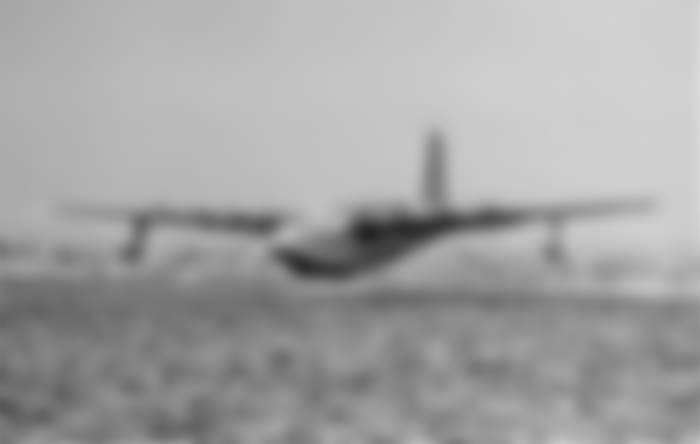the 10 largest single vehicles in the world
Humans have built truly colossal vehicles. Unfortunately, most of them never got beyond a single prototype precisely because their size made them too expensive to manufacture, or because of technical problems derived from their size. These are some of them.
1) Antonov An-225 Mriya (Антонов Ан-225 Мрія)
Impossible to start this top of unique giants in any other way. Introducing the Antonov An-225, the dream of the world's largest aircraft. Its wings measure 88.4 meters from tip to tip, and it is 84 meters long. There was only one unit in the world, which flew for the first time in 1988. Since then, it remained in active service until February 5, 2022, the next day it was destroyed by Russian bombing at Hostomel airport, although no more have been built simply because it is too expensive. By the year 2000 Russia started to build another one, but the project is stalled due to lack of budget. it holds several air cargo records. the maximum? 253,820 kilos. a real colossus that will be sorely missed even if it is promised to rebuild a new one with state-of-the-art technology to help recover the country after the conflict ends.

2) Hughes H-4 Hercules Sprooce Goose
We said that the An-225 is the largest aircraft, but it is not the largest ever built. That title goes to the H-4 Hercules, a massive military transport seaplane built in the 1940s by tycoon Howard Hughes at the request of the War Department.
The H-4 was never produced in time for the conflict, and only made a brief test flight on November 2, 1947. Today it can be seen at the Evergreen Aerospace Museum in Oregon, USA.

Panzerkampfwagen VIII Maus
The Nazis built two units of this colossal tank, but only one was ever completed, and it was requisitioned by the Russians after World War II. Today, the prototype is on display at the Kubinka Tank Museum in Russia.
The Panzer VIII Maus still holds the record for the largest closed armored vehicle ever built. It weighed 188 tons and was 10.2 meters long, 3.71 meters wide and 3.63 meters high. The most curious thing is that its engine was hybrid (electric and fuel). Its speed record was set at 22 km/h. Very few bridges could withstand the weight of this tank, so the Germans equipped it with a snorkel to be able to travel underwater up to 13 meters deep.

object 279 (Объект 279 Котин)
ith this strange name hides the prototype of a supertanker built by the Russian Army in 1957, which was intended to serve as a mobile command post for Russian artillery commanders in the hypothetical event of a third world war.
Object 279 was 11 meters long (including the cannon), 3.4 meters wide and 2.6 meters high. It was not as big as the Maus, but it was so heavy (60 tons) that it had to be fitted with a couple more tracked tractors. Its armor could withstand normal anti-tank ammunition, and it was said that it could even withstand the shock wave of a nuclear bomb.

Terex 33-19 "Titan"
For 25 years, the Titan was the world's most massive heavy-duty truck. It was built by the Terex Comp
any, a subsidiary of General Motors, in 1973 and served for 13 years before being left as a showpiece in Sparwood, Canada.
The Terex 33-19 was 20.3 meters long, 7.80 meters wide and 6.88 meters high. Its engine was a 160-liter V-16 turbodiesel. The largest truck in the world today is the Russian BelAZ 75710 (below), which measures 20.6 x 9.87 x 8.16 meters. It is powered by two 16-cylinder engines with 2,300 hp each (and a few have already been built).

Marion 6360 El Capitan
The colossus you see in the picture has the honor of having been, during its reign, the heaviest land vehicle in history, and also the largest single shovel excavator ever built. Its size is perhaps not well appreciated in the above photo. Below is a detail of his crawler tractor.
The Marion 6360 was built by the Marion Power Shovel Company for a mining company in Illinois. It served there until 1991, when a fire caused such severe damage to the machinery that it was too expensive to repair, so it was scrapped. It was 64 meters high and weighed 12,700 tons. With its 15,000 horsepower engine, it moved 96 cubic meters of earth with each shovelful.

Netopyr Tank
Also known as the Tsar's Tank or Lebedenko Tank in honor of its creator, this 1915 Russian tank moved on three wheels. The two largest were 9 meters high, and the smallest 1.5. Driving each wheel was a 240 horsepower engine that allowed it to reach a maximum speed of 17 km/h.
The Netopyr (Murcielago) was 18 meters long and 12 meters wide. On the road it moved without any problem, but its more than 60 tons and those wheels proved useless as soon as it encountered an obstacle. Finally it was decided to abandon the project and the only unit that was built ended up in the scrapyard.

LeTourneau TC-497 Overland Train Mark II
It was the 1950s and the United States was wondering: What if the enemy destroys our roads and railroads? Beset by that insidious question, the military commissioned Texas-based industrial equipment firm LeTourneau to develop a means of large-scale ground transportation that would not rely on roads and railroads.
LeTourneu's answer was the Overland Trains or Logistics Cargo Carrier (LCC) as they liked to call it in the Army. The LCCs were something like a train, but capable of driving over any terrain thanks to their huge wheels. The largest of them all was the TC-497 Mark II, created in 1958.
The tractor head of this monstrous convoy was equipped with a 1,170-horsepower gas turbine, but it was not enough. Interspersed between the cars were three other similar engines to assist. It had a total length of 183 meters, which qualifies it as the longest off-road vehicle ever made. Of that land train, only the locomotive remains, which can still be seen at the Yuma Proving Ground in Arizona.

Bagger 293
The Bagger 293 is the culmination of a series of mining excavators manufactured by the German company TAKRAF. Although they are a family, the 293 is the only one of its kind, and still holds the Guinness record for the largest land vehicle. It is 96 meters high, 225 meters long, and weighs 14,200 tons. Its digging head (pictured) has a diameter of about 20 meters, and can move 240,000 cubic meters of earth per day. It is currently serving in a coal mine near Hambach, Germany.

Flying Fortress Kalinin K7 (Калинин К-7)
53 meters wingspan may seem small compared to the Antonov An-225's 82 meters, but if we are talking about a propeller-driven aircraft built in the 1930s, things change quite a bit. At that time, the Russians were obsessed with building air fortresses, and the closest they came is the Kalinin K7, a real monster designed by Konstantin Alexeivich Kalinin.
All kinds of crazy sketches of the military version of this aircraft are circulating on the internet, even including large-caliber cannons, something that would probably be unfeasible. What is known for sure is that the K7 was powered by seven engines, and carried six 7.62 mm ShKAS machine guns and up to 9,000 kg of bombs (more than a B-29). The civilian version would have held 120 passengers. Unfortunately, it crashed a few months after its maiden flight and no more were ever produced.










